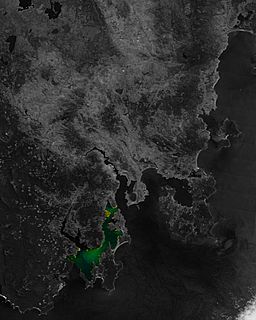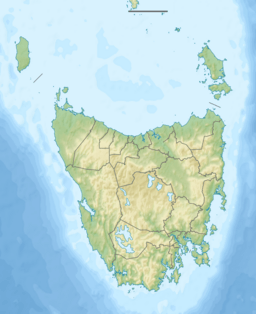D'Entrecasteaux Channel facts for kids
Quick facts for kids D'Entrecasteaux Channel |
|
|---|---|

South East Tasmania with D'Entrecasteaux Channel highlighted.
|
|
| Location | South East Tasmania |
| Coordinates | 43°13′S 147°17′E / 43.217°S 147.283°E |
| Type | Channel |
| Etymology | Vice-Admiral Bruni D'Entrecasteaux |
| River sources | Derwent River; Huon River |
| Primary outflows | Tasman Sea |
| Ocean/sea sources | South Pacific Ocean |
| Basin countries | Australia |
| Settlements | Snug, Margate, Kettering, Woodbridge, Flowerpot, Middleton, Gordon |
The D'Entrecasteaux Channel /ˌdɒntrəˈ[unsupported input]stoʊ/ is a cool stretch of water in Tasmania, Australia. It's found between Bruny Island and the main part of south-east Tasmania.
This channel is where the Derwent and Huon Rivers meet the sea. Their waters flow out into the Tasman Sea, which is part of the huge South Pacific Ocean.
Many towns are located along the D'Entrecasteaux Channel. These include Snug, Margate, Kettering, Woodbridge, Flowerpot, Middleton, and Gordon.
Contents
Discovering the D'Entrecasteaux Channel
The D'Entrecasteaux Channel has a long and interesting history.
First Sightings and Indigenous Heritage
Long before Europeans arrived, this area was very important to the Nuenonne band of the South East tribe. These were the Indigenous peoples of Tasmania.
The channel was first seen by European explorers in 1642. This was when Abel Tasman, a Dutch explorer, sailed past the area.
How the Channel Got Its Name
The channel is named after a French explorer. On April 20, 1792, French Vice-Admiral Bruni D'Entrecasteaux was exploring the area. He was sailing in his ships, the Recherche and Esperance.
He was looking for another explorer, La Perouse, who was lost. D'Entrecasteaux was trying to find a safe place to anchor his ships. Because he was ill, his navigators accidentally sailed into the channel. This happened instead of going around Bruny Island. So, the discovery of this big channel was actually an accident!
Whaling History
In the early 1800s, whaling was a big industry. Many whaling stations were set up along the shores of the D'Entrecasteaux Channel. These stations were used to process whales caught in the nearby seas.
Nature and Environment
The D'Entrecasteaux Channel is a beautiful place with unique natural features.
Protecting the Coastline
The channel is protected by Bruny Island, which helps keep the waters calm. However, the coastline along the channel is slowly changing. In some places, people use sandbags to help protect the land from being washed away by the water.
Scallops and Fishing
The channel is a special place for scallops to grow. Scallops are a type of shellfish. For a long time, people used special fishing tools called dredges to collect scallops from the seafloor.
However, this method caused damage to the seabed. Because of this, since 1969, scallops are now collected by scuba divers. This way, the environment is protected.
Stargazing and Aurora Australis
The D'Entrecasteaux Channel is a popular spot for photographers. They love to capture amazing pictures of the aurora australis. This is also known as the Southern Lights.
The channel has many views facing south, which are perfect for seeing the colorful lights in the sky. However, lights from nearby salmon farms can sometimes make it harder to see the aurora clearly.
Gallery
See also
 In Spanish: Canal d'Entrecasteaux para niños
In Spanish: Canal d'Entrecasteaux para niños




